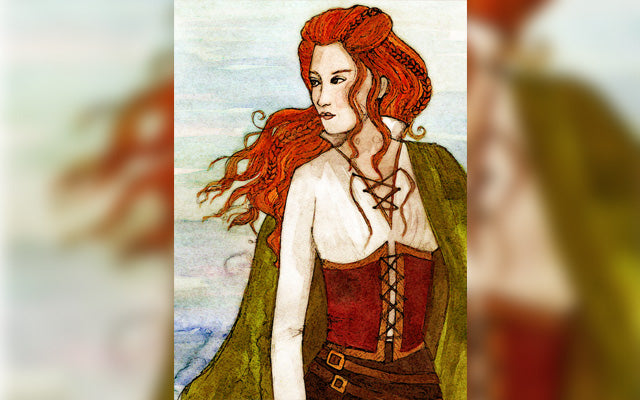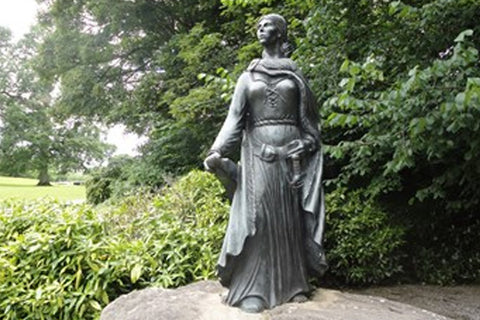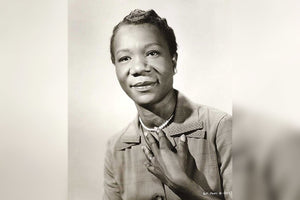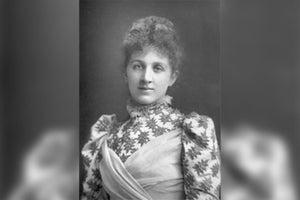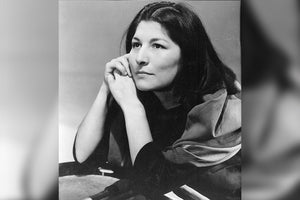Lived: c. 1530 – c. 1603
Who was Grace O’ Malley?
She was the 16th-century pirate queen of Ireland who raised and led armies, commanded a fleet of ships, was captured (twice), imprisoned, faced execution, secured her freedom (twice), fought pirates, and was a master of political negotiation.
Five Facts about Grace O’ Malley:
-
In her native tongue, her name was Gráinne Ní Mháille.
-
To the English, she was considered a brutal and thieving pirate, who controlled the coastlines through intimidation and plunder.
-
Folklore suggests that Grace was pregnant with her son Tiobóid while at sea. Within an hour of giving birth, Algerian pirates ambushed and boarded her ship. Wrapping the child in a blanket, she appeared on deck and rallied her crew, leading to the capture of the pirate vessel.
-
A statue of Grace is on display at Westport House, Ireland.
-
She most likely died at Rockfleet Castle around 1603, the same year as Queen Elizabeth's death, though the year and place of Grace’s death are disputed.
Inspirational Song Excerpt Written About Grace O’ Malley
[…]‘Twas a proud and stately castle
In the years of long ago
When the dauntless Grace O'Malley
Ruled a queen in fair Mayo
And from Bernham's lofty summit
To the waves of Galway Bay
And from Castlebar to Ballintra
Her unconquered flag held sway
She had strongholds on her headlands
And brave galleys on the sea
And no warlike chief or viking
E'er had bolder heart than she
She unfurled her country's banner
High o'er battlement and mast
And ‘gainst all the might of England
Kept it flying to the last
The armies of Elizabeth
Invaded her on land
Her warships followed on her track
And watched by many a strand
But she swept her foes before her
On the land and on the sea
And the flag of Grace O'Malley
Waved defiant proud and free […]
Grace’s Biography
Early Life
Grace was born in Ireland around 1530 as a daughter of the wealthy nobleman and sea trader Dubhdara O'Malley, who commanded the biggest fleet of ships in Ireland.
Local folklore had it that Grace, as a young girl, wished to go on a trading expedition to Spain with her father. Upon being told she could not because her long hair would catch in the ship's ropes, she cut off most of her hair to embarrass her father into taking her. This earned her the nickname "Gráinne Mhaol" (meaning bald or having cropped hair).
Husband and Children
In 1546, Grace married and bore three children to Dónal an Chogaidh, who was later killed in an ambush. She then remarried “Iron Richard” Bourke, with whom she had one child.
Turning Point
Grace O'Malley was Queen of Umaill, chieftain of the O Maille clan. She was a rebel, seafarer, and fearless leader who challenged the turbulent politics of 16th century England and Ireland. Irish legends immortalized Grace as a courageous woman who overcame boundaries of gender imbalance and bias to fight for the independence of Ireland and protect it against the English crown.
Mission and Work
For hundreds of years, the O’Malleys had been sailing their ships around the coasts of Ireland, Scotland, and northern Spain, trading, fishing, and plundering. They were one of the few seafaring families on the west coast, and they built a row of castles facing the sea to protect their territory. From their base at Rockfleet Castle, they plundered ships and fortresses on the shoreline and on Scotland’s outlying islands and taxed all those who fished off their coasts, which included fishermen from as far away as England. O'Malley's ships would stop and board the traders and demand either cash or a portion of the cargo in exchange for safe passage the rest of the way to Galway.
When her father died, Grace inherited his large shipping and trading business. From her earliest days, she rejected the role of the 16th-century woman, instead embracing the life on the sea with the O'Malley fleet. The income from this business, as well as land inherited from her mother, enabled her to become wealthy and powerful.
During a time when Ireland was ruled by dozens of local chieftains, Grace commanded hundreds of men and some 20 ships in raids on rival clans and merchant ships. She also had many run-ins with government officials, who made repeated attempts to curb her activity.
To be a female commander of pirates was very dangerous. To earn the respect and protection of her men, Grace had to lead from the front and be as courageous as those she commanded. And she knew the great risk of what she did – the penalty for piracy was death by hanging.
And when things got bad for her and her family, she determined to meet with the Queen of England, despite the fact that she could have been executed just for trying. However, Queen Elizabeth was intrigued by this head-strong, rebel woman. Grace and Elizabeth shared something in common – they were both powerful women in what was, at the time, very much a man’s world. Through carefully worded letters and petitions to the Queen’s advisors, Grace secured her meeting with one of the most powerful women of her era.
Death and Legacy
Grace lived to be 70 years old and her story lives on as many folk stories, poems, songs, and musicals that have continued to this day, thus preserving the legend of the Pirate Queen.
![]() Fast Shipping
Fast Shipping![]() Subscribe to our Newsletter
Subscribe to our Newsletter![]() 🌟 New Global Competition 🌟
🌟 New Global Competition 🌟